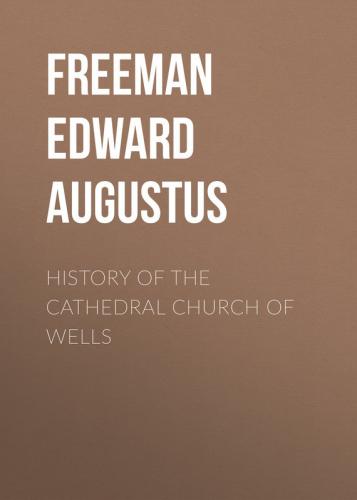Bishop Robert, having thus settled himself as Bishop of Bath and Wells, with two churches under his special care, began to set to work to put in order whatever needed reform in both of them. He enlarged and finished the church of Bath, if he did not actually rebuild it from the ground. I speak thus doubtingly, because our accounts do not exactly agree. The little book called "Historiola de Primordiis Episcopatûs Somersetensis" says that "he himself caused the church of the Blessed Peter the Apostle at Bath to be built at a great cost."51 But the history commonly quoted as the Canon of Wells says only that "he finished the fabric of the church of Bath which had been begun by John of Tours."52 Now the "Historiola" is the earlier authority, and that which we should generally believe rather than the other, whenever there is any difference between the two. But, on the other hand, stories generally grow greater and not smaller; a man's exploits are much more likely to be made too much of by those who repeat the tale than to be made too little of. When therefore the later writer attributes to Robert less than the earlier one does, one is tempted to think that the earlier writer exaggerated or spoke in a loose way, and that the Canon of Wells had some good reason for his correction. And this is the more to be noticed, because we shall find exactly the same difference when we come to the accounts which the two writers give of what Robert did at Wells. It is indeed said that the church and city of Bath were again destroyed by fire in 1135, and that this made Robert's rebuilding necessary. But the phrase of being destroyed by fire is often used very laxly of cases where a building, like York Minster within the memory of some people, was simply a good deal damaged, and had to be repaired, but did not need to be wholly rebuilt. At any rate, whether Robert altogether rebuilt or only finished, the great church of Saint Peter at Bath was now brought to perfection. Do not for a moment think that this is the Abbey Church of Bath which is now standing, and which I do not doubt that a great many of you know very well. The church of John and Robert was of course built in the Romanesque style with round arches, and in that particular variety of Romanesque which had been imported by Eadward the Confessor from Normandy into England, and which we therefore call the Norman style. But the present church of Bath is one of the latest examples of our latest English Gothic, and of that special variety of it which forms the local Perpendicular style of Somersetshire. Moreover the Romanesque church was very much larger than the present one, which covers the site of its nave only. One little bit of the Romanesque building, the arch between the south aisle and the south transept, is still to be seen at the present east end. The fact is that the later Bishops of Bath and Wells were not at all of the same mind as John of Tours. They lived much more at Wells than at Bath, and took much more care of the church of Wells. Bath indeed was quite neglected, and by the end of the fifteenth century the church was in a great state of decay. It was then, in the year 1500, that Bishop Oliver King and Prior Bird began to build the present church on a smaller scale and in a widely different style of architecture. Besides what he did to the church, Bishop Robert built or rebuilt all the conventual buildings of his Abbey of Bath, the cloister, refectory, dormitory, and the rest, all which were necessary for the monks of Bath, though the secular priests of Wells could do without them.53
Конец ознакомительного фрагмента.
Текст предоставлен ООО «ЛитРес».
Прочитайте эту книгу целиком, купив полную легальную версию на ЛитРес.
Безопасно оплатить книгу можно банковской картой Visa, MasterCard, Maestro, со счета мобильного телефона, с платежного терминала, в салоне МТС или Связной, через PayPal, WebMoney, Яндекс.Деньги, QIWI Кошелек, бонусными картами или другим удобным Вам способом.
